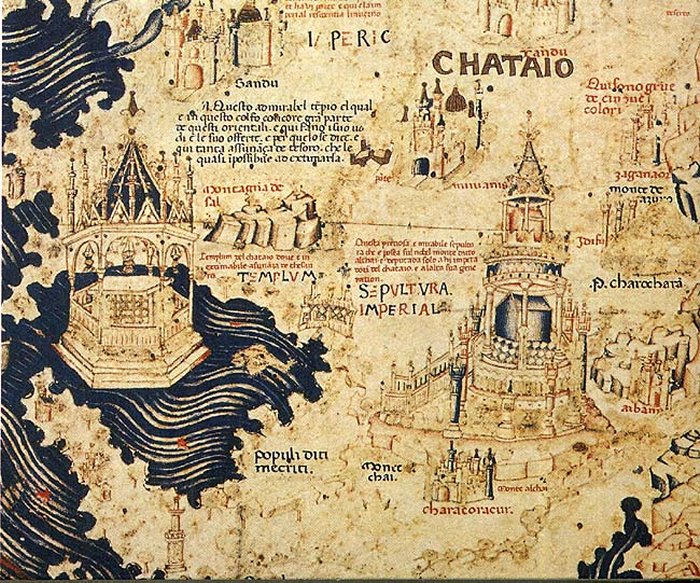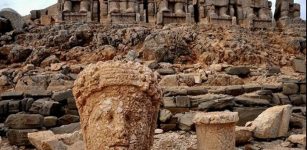Fra Mauro Medieval Map: Accurate And Detailed Work Attesting To Advanced Geographic Knowledge Of Contemporary Cartographers
A. Sutherland - AncientPages.com - Monumental map of Fra Mauro is one of the most beautiful and important works in the history of cartography. The map is believed to be the ultimate memorial of medieval cartography. It was the most detailed and accurate map of the world up until that time.
It was created in a monastery on the Venetian island of Murano about 1450.

The Fra Mauro Map – Part of China. 1459. Source
The map presents the most comprehensive image of the cosmos as it was known in the mid-15th century. It expresses the Christian vision of the world and the Christian vision of the world disseminated in the early renaissance.
At the same time, Fra Mauro Map announces the decline of the medieval so-called ‘mappae mundi’, whose task was to teach biblical geography. Mappae Mundi were highly influenced by Christianity (with Jerusalem located at the center) and created during the Middle Ages (400-1450) and oriented with the east.
Who Was Fra Mauro?
Fra Mauro who died in 1464, was an Italian cartographer who lived in the Republic of Venice. He traveled much as a soldier and a merchant. He was also a member of the Monastery of St. Michael, situated on the island of Murano, just outside Venice, norther Italy It was there that he maintained a cartography workshop.
From the 1450s, he is also mentioned as the creator of several world maps. Due to his religious status, Fra Mauro was no longer free to travel, but he could frequently consult with merchants of the city upon their return from overseas voyages.
The Republic of Venice was a sovereign state and a powerful maritime state in northeastern Italy, which flourished for over a millennium between the 7th century and the 18th century from 697 AD until 1797 AD.
Fra Mauro was employed as an accountant and professional cartographer. The map was made for the two most prominent seafaring nations of the time, Venice and Portugal.
Approach To Create The Fra Mauro Map
Fra Mauro clearly tried to use the latest mapping techniques to show the latest discoveries, even if they contradicted the views of classical and Christian geography. He was a cartographer who wanted to definitely break from divinely inspired maps of the Dark Ages.
Although the Earth was inscribed by Fra Mauro in the traditional form of the circle, with a large number of graphic representations of towns and cities, he wanted his map to show an element of a broader cosmological vision, enclosed in a square frame and including paradise and cosmos (shown in the form of three astronomical diagrams).
This detail from Fra Mauro's world map shows the city of Ayutthaya ("Scierno"), a name derived from the Persian name of the city "Shar-I-Nau", meaning "New City". The map is orientated with south to the top. To the right - two cities in Burma can be recognized: "Pochang" (present-day Bagan) and Ava (present-day Inwa). Image credit: Fra Mauro/wikipedia
Appearance And How Long Did It Take To Create It?
One of the attributes of the map is its southern orientation, instead of the northern one, earlier used by Ptolemy and eastern, typical of the medieval mappae mundi, which showed at the top where Garden of Eden was usually depicted.
Fra Mauro wanted to place the Garden of Eden outside the world, rather than in the extreme east.
Other features of this map show that Jerusalem was moved from the center of the world to its periphery, and southern Africa was presented as if it could be circumnavigated - even though the Portuguese were the first Europeans to circle the Cape of Good Hope only in 1488.
The map forms a circular planisphere drawn on parchment and set in a wooden frame that measures about 240 x 240 cm. It includes Asia, the Indian Ocean, Africa, Europe, and the Atlantic. It is oriented with south at the top.
On the map, there are 3000 inscriptions informing about the latest news from the accounts of people traveling to Africa and Asia. They contain a lot of often very detailed information on both of these continents; one of them is related to the description of Japan.
A large team of cartographers, copyists, and artists worked on the map including Fra Mauro. They used the best-known pigments and gold to achieve the best effects.
The work, which was very expensive and took several years, contains hundreds of very detailed illustrations and more than 3000 descriptive texts.
Fra Mauro map marks the end of Bible-based geography in Europe and the beginning of embracing a more scientific way of making maps, placing accuracy of the mapping ahead of traditional and religious beliefs.
The map is usually on display in the museum Museo Correr in Venice in Italy.
Written by – A. Sutherland - AncientPages.com Senior Staff Writer
Copyright © AncientPages.com All rights reserved. This material may not be published, broadcast, rewritten or redistributed in whole or part without the express written permission of AncientPages.com
Expand for referencesReferences:
James Cowan, A Mapmaker’s Dream
More From Ancient Pages
-
 Draupnir: God Odin’s Magical Ring That Could Multiply Itself
Featured Stories | Jul 26, 2017
Draupnir: God Odin’s Magical Ring That Could Multiply Itself
Featured Stories | Jul 26, 2017 -
 How Reliable Are Computer ‘Reconstructions’ Of Faces From Ancient Times?
Featured Stories | Sep 3, 2024
How Reliable Are Computer ‘Reconstructions’ Of Faces From Ancient Times?
Featured Stories | Sep 3, 2024 -
 Why Was The Iron Age Village Near Elgin In Scotland Suddenly Abandoned And Burned Down?
Archaeology | Jul 29, 2022
Why Was The Iron Age Village Near Elgin In Scotland Suddenly Abandoned And Burned Down?
Archaeology | Jul 29, 2022 -
 The Iron Man In The Kottenforst And Other Puzzling Ancient Artifacts Of Unknown Origin And Purpose
Featured Stories | Mar 10, 2014
The Iron Man In The Kottenforst And Other Puzzling Ancient Artifacts Of Unknown Origin And Purpose
Featured Stories | Mar 10, 2014 -
 Major Discovery Reveals Neanderthals In Italy Engaged In Plant Food Processing
Evolution | Jun 29, 2023
Major Discovery Reveals Neanderthals In Italy Engaged In Plant Food Processing
Evolution | Jun 29, 2023 -
 Sphinx Room Discovered At Emperor Nero’s Famed Domus Aurea (Golden House)
Archaeology | May 9, 2019
Sphinx Room Discovered At Emperor Nero’s Famed Domus Aurea (Golden House)
Archaeology | May 9, 2019 -
 Legend Of Bochica And Mysterious Ancient Stone Structures In Colombia
Featured Stories | Jun 5, 2016
Legend Of Bochica And Mysterious Ancient Stone Structures In Colombia
Featured Stories | Jun 5, 2016 -
 Our Lineage’s Species Formation Pattern Was Unlike Anything Else
Evolution | Apr 18, 2024
Our Lineage’s Species Formation Pattern Was Unlike Anything Else
Evolution | Apr 18, 2024 -
 King Khufu’s 4,600-Year-Old Solar Boat Has Been Transported To The Grand Egyptian Museum
Archaeology | Aug 9, 2021
King Khufu’s 4,600-Year-Old Solar Boat Has Been Transported To The Grand Egyptian Museum
Archaeology | Aug 9, 2021 -
 Ancient Human Remains A The Sima De Los Huesos Site Investigated
Archaeology | Mar 15, 2023
Ancient Human Remains A The Sima De Los Huesos Site Investigated
Archaeology | Mar 15, 2023 -
 White Temple Of God Anu In Sacred Precinct Of Kullaba At Uruk
Civilizations | Oct 10, 2016
White Temple Of God Anu In Sacred Precinct Of Kullaba At Uruk
Civilizations | Oct 10, 2016 -
 Lemminkainen: Mythical War-Hero Of Finnish Great Epic ‘Kalevala’
Featured Stories | Oct 14, 2016
Lemminkainen: Mythical War-Hero Of Finnish Great Epic ‘Kalevala’
Featured Stories | Oct 14, 2016 -
 Mysterious Stone Spheres Could Be From Ancient Greek Board Game – Scientists Say
Archaeology | Sep 30, 2022
Mysterious Stone Spheres Could Be From Ancient Greek Board Game – Scientists Say
Archaeology | Sep 30, 2022 -
 10 Ancient Love Symbols
Featured Stories | Mar 2, 2023
10 Ancient Love Symbols
Featured Stories | Mar 2, 2023 -
 Mythical Submerged City Of Ys – Europe’s Own Sodom And Gomorrah
Featured Stories | Feb 1, 2023
Mythical Submerged City Of Ys – Europe’s Own Sodom And Gomorrah
Featured Stories | Feb 1, 2023 -
 Daily Life Of Priests And Priestesses In Ancient Egypt
Ancient History Facts | Apr 5, 2018
Daily Life Of Priests And Priestesses In Ancient Egypt
Ancient History Facts | Apr 5, 2018 -
 Kommagene Civilization And The Ancient City Of Perge
Civilizations | Jan 25, 2016
Kommagene Civilization And The Ancient City Of Perge
Civilizations | Jan 25, 2016 -
 Ancient Round Coins Were Invented To Prevent Fraud
Ancient History Facts | Mar 21, 2018
Ancient Round Coins Were Invented To Prevent Fraud
Ancient History Facts | Mar 21, 2018 -
 Brahma: First God In Hindu Trimurti, Creator Of The World And All Creatures
Featured Stories | Apr 17, 2019
Brahma: First God In Hindu Trimurti, Creator Of The World And All Creatures
Featured Stories | Apr 17, 2019 -
 Secrets Of Lake Huron – Mysterious Disappearance Of Long-Lost Steamship Solved
Archaeology | Nov 3, 2023
Secrets Of Lake Huron – Mysterious Disappearance Of Long-Lost Steamship Solved
Archaeology | Nov 3, 2023



